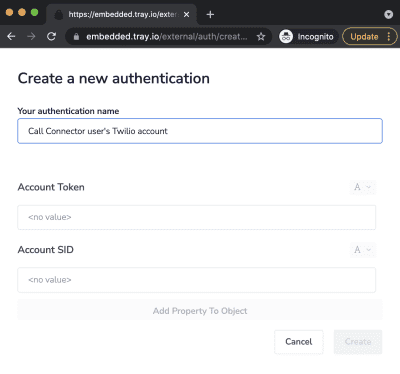Create new auths
If you need to prompt your End Users to create new auths from scratch, you can make use of Tray's auth-only dialog:

1 - Generate an auth code for the End User
In order to open the auth collection dialogue so that the user can provide their authentication details, an authorization code needs to be obtained using the Create Auth-dialog authorization code endpoint.
This endpoint requires a master token and the userId created above. The code returned by this endpoint is single-use and expires after 5 minutes:
mutation {
generateAuthorizationCode(
input: { userId: "fbb96559-xxxx-xxxx-xxxx-5552c2d2fca4" }
) {
authorizationCode
clientMutationId
}
}{
"data": {
"generateAuthorizationCode": {
"authorizationCode": "b8aab26cxxxxxxxxxxxxxxxxxxxx776c7bba7977",
"clientMutationId": null
}
}}2a - Assemble the auth-only dialog URL
You can now assemble the URL that will be passed to your user to collect authentication details for a particular connector:
https://embedded.tray.io/external/auth/create/{partnerName}?code={authorizationCode}&serviceId={serviceId}&serviceEnvironmentId={serviceEnvironmentId}&scopes[]={scopes}
info
The 'embedded.tray.io' domain can be white-labeled
Please see our page on Custom OAuth apps for more info
You will direct your user to a popup window with this URL.
-
partnerNameis the 'Embedded ID' that can be set/viewed in the embedded settings page (seen here) -
authorizationCodeis the single-use authorization code generated in the previous step -
serviceIdwas retrieved in the 'Get service version and serviceId' step above -
serviceEnvironmentIdwas retrieved in the 'Get serviceEnvironmentId' step above -
scopesare the OAuth scopes required to ensure that the necessary permissions are set once the OAuth flow is completed:-
Each scope needs to be passed as an individual parameter, so it should look something like this:
&scopes[]=channels:read&scopes[]=channels:write
-
Each scope needs to be passed as an individual parameter, so it should look something like this:
Available scopes can be identified using the Get service environments endpoint
(Note that this only returns the available scopes and doesn't indicate what scopes are actually required for any particular connector operation. Also note that this may not be a complete list of all available scopes. Please consult 3rd party docs for more information)
{
"elements": [
{
"id": "35cf89a9-5d49-44b3-ba10-7c78324da260",
"title": "Production",
"authenticationType": "oauth2",
"userDataSchema": {...},
"credentialsSchema": {...},
"scopes": [
{
"scope": "chat:write:bot",
"description": "Send messages as tray.ai"
},
{
"scope": "chat:write:user",
"description": "Send messages as user"
},
{
"...": "...",
"...": "..."
}
]
}
]
}{
"elements": [
{
"id": "d403c9c6-282b-4b8c-ad02-1655ebccb166",
"title": "Production",
"authenticationType": "oauth2",
"userDataSchema": {...},
"credentialsSchema": {...},
"scopes": [
{
"scope": "full",
"children": [
"id"
],
"description": "Allows access to all data accessible by the logged-in user, and encompasses all other scopes (except refresh token)."
},
{
"scope": "refresh_token",
"children": [
"id"
],
"description": "Allows a refresh token to be returned, allowing for offline access."
},
{
"scope": "api",
"children": [
"chatter_api"
],
"description": "Allows access to the current, logged-in user's account using APIs, such as REST API and Bulk API. This value also includes chatter_api, which allows access to Chatter REST API resources."
},
{
"...": "...",
"...": "...",
"...": "..."
}
]
}
]
}2b - Example auth-only dialog URL
A valid auth collection URL would look like this:
https://embedded.tray.io/external/auth/create/traydemoaccount?code=5fb286bbxxxxxxxxxxxxxxxx3484c63201f&serviceId=55d1154c-4fd8-4c2c-ba22-041deabfcbfd&serviceEnvironmentId=973b1afa-aa13-42c7-86c3-3964f44c53dd
The service ID and service environment ID correspond to the Twilio connector.
No scopes are required because the Twilio connector uses token-based authentication.
The URL will take your user to a dialogue where they can provide their Twilio credentials:

3 - Retrieving the authId
The auth dialogue sends messages to the window that opened it. You can listen to these events and take action accordingly.
Check out the page on Auth-dialog events.
Here's a snapshot of the success event logged onto the console. You can directly grab the authId from this event and use it in the next steps of the user journey.

The other way to get the fresh auths for the user after auth dialouge is finished is to perform the Get User Authentications (user token) endpoint from Users API (GraphQL).
query {
viewer {
authentications {
edges {
node {
id
name
customFields
service {
id
name
icon
title
version
}
serviceEnvironment {
id
title
}
}
}
pageInfo {
hasNextPage
hasPreviousPage
}
}
}
}{
"data": {
"viewer": {
"authentications": {
"edges": [
{
"node": {
"id": "569xxxxxx-xxxxx-xxxx-7e829d2c56d",
"name": "Roger Ramjet's Slack Account",
"service": {
"id": "227312c4-3e5f-4b0d-22a0-5b9630ece00e",
"name": "slack",
"icon": "https://s3.amazonaws.com/images.tray.io/artisan/icons/slack.png",
"title": "Slack",
"version": "1"
}
}
},
{
"node": {
"id": "0b07xxxxxx-xxxxx-xxxx-b8d4121471c3",
"name": "Roger Ramjet's Trello Account",
"service": {
"id": "72cef4e9-229f-4d7c-97e3-b6cd4d92146f",
"name": "trello",
"icon": "https://s3.amazonaws.com/images.tray.io/artisan/icons/trello.png",
"title": "Trello",
"version": "1"
}
}
},
{
"node": {
"id": "a29dxxxxxx-xxxxx-xxxx-99901f41c698",
"name": "Roger Ramjet's Slack Account 2",
"service": {
"id": "227312c4-3e5f-4b0d-22a0-5b9630ece00e",
"name": "slack",
"icon": "https://s3.amazonaws.com/images.tray.io/artisan/icons/slack.png",
"title": "Slack",
"version": "1"
}
}
}
]
}
}
}
}